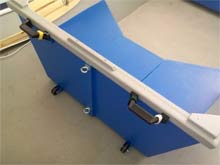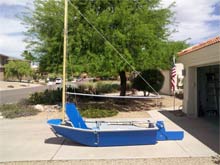Hi Chuck,
As I have been hard at work making the Pollywog into a day sailer, I thought perhaps your readers would like to see what progress has been made. The sail type chosen for the boat is a Cat Rig style. Easy to make and easy to manage. Once that decision was made the rest just kind of fell into place. The mast proved to be a challenge, as I wanted it to be a take-apart design, to nest in the aft section of the boat for transporting. I settled on a composite mast made of 1x2x8’ lumber, assembled to form a hollow into which the halyard would pass. The following photos should provide sufficient visual detail of the design and build. A prospective builder could opt for a one piece mast design, making the build that much easier.
 |
3 MAST SECTIONS, each 4 feet long. Mast base, center and head sections. |
 |
The mast sections fit together using an interlocking feature and a 12 inch center pipe for rigidity. |
 |
Once assembled, the mast becomes a straight, rigid structure. |
 |
The mast head with the halyard emerging over the pulley. The boom line is also shown. |
Remember that my woodworking skills are limited, and the finished product by an attentive builder should look much better. The delay in construction now is the sail material. I have ordered the white polytarp from the source you suggested, but they have shipped it ground from South Carolina, and it will take a week to get here in Arizona. Uggh!
 |
All the rigging stored in the aft hull section for transport |
 |
Stepped mast, daggerboard in place, stainless stays tightened. |
 |
Non-pivoting caster wheels to assist in ground transport. |
Once received, I expact a week of work to fit it to the boat, and then it’s off to the lake for testing. With approximately only 36 square feet of sail, I do not expect too many surprises, which is in keeping with the safety aspect of the original Pollywog design. Many years ago I experienced a knockdown in a larger sailboat I owned, and the memory remains with me to this day.
 |
Bottom of forward hull showing daggerboard slot (offset to clear mast) and the three skids. The handle is to assist in transport to the water or back to vehicle. The two little skid extensions are really hull interlocks, preventing the two sections from twisting away from each other. |
Once the water tests are complete I will issue the plans to you. Currently there are 28 pages of text, photos and a bill of materials, just for the sail version. The hull plans are an additional 36 pages, as you already know. My best estimate of cost for the sail rig is under $200 at this time, but this includes some fittings that could be replaced with marine hardware, if the boat is to be used in salt water or rough environments. All this is explained within the text of the plans.
 |
Aft section with tiller, sheet and paddle storage. |
 |
Pollywog final assembly, daggerboard up, rudder raised. Waiting for a sail and water! |
As always, many thanks for your continued support of the small boat building community.
Best regards, Ken Simpson
*****
More Articles by Ken Simpson
|

